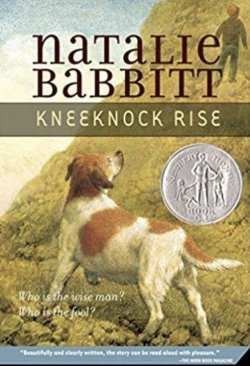Gareth B. Matthews

Review of Knee-Knock Rise by Natalie Babbitt (New York: Farrar, Straus & Giroux, 1970). Originally published in Thinking: The Journal of Philosophy for Children 8(2): 1.
Wanting to visit the annual fair in the nearby village of Instep, young Egan goes off to stay with his Uncle Anson and Aunt Gertrude, who live in Instep with their daughter, Ada. It is Ada and her cat who greet Egan on his arrival; they give him a somewhat ambivalent reception. Egan is put up in a room recently occupied by a mysterious relative, Uncle Ott, and his dog, Annabelle.
Egan is soon told about the Megrimum, a phantom that appears atop the nearby mountain, Knee-Knock Rise, during rain and sends out from there its mournful wail. On his first night in In step, Egan hears the Megrimum’s wail, which, on this particular occasion, is followed by the appearance of a mysterious face at Egan’s window.
These excitements do not blemish Egan’s fun at the fair the next day. To the contrary, Egan buys good things to eat and drink, plays games, and happily buys presents for his relatives.
At suppertime the sky begins to cloud over and, as the fair booths are being closed up, the villagers excitedly anticipate rain and the ensuing wait of the Megrimum. Egan’s cousin Ada dares him to mount Knee-Knock Rise to confront the Megrimum. When Egan accepts the challenge, Ada becomes frightened. While Egan bounds up the mountain with Uncle Ott’s dog, Ada summons her father to rescue Egan from the Megrimum.
Atop Knee-Knock Rise Egan encounters, not the Megrimum, but his mysterious Uncle Ott, who admits that it was his face that had appeared at Egan’s window the night before. Now, happily reunited with his dog, Uncle Ott explains to Egan that the Megrimum is really a cloud of steam that forms whenever rainwater falls on a sulfur spring at the mouth of a cave on top of the mountain. The Megrimum’s wail is just the sound the steam makes when it passes through a small hole under very high pressure.
Enlightened with this knowledge, Egan throws a rock into the steam hole to silence the phantom. Triumphant, he returns to the village to expose the myth of the Megrimum. But alas! no one will believe him. The villagers of Instep, for various personal and communal reasons, need to believe in the Megrimum.
For me this simple and wise story makes several connections with my own youth as a boy scout. Admittedly, there was no Megrimum in the hills where we scouts used to camp, no Loch Ness Monster in the lake where we boated and swam, and no Abominable Snowman in the forests where we hiked. But we had lots of ghost stories to tell anyway. In fact, an evening of ghost stories around the campfire was always one of our favorite occasions.
We scouts, like Ada in Natalie Babbitt’s story, relished the chance that an evening of ghost stories presented to frighten neophytes in our circle. But, again like Ada, we old-timers often ended up being ourselves more frightened by the latenight sounds than the tenderfeet whom we had meant to initiate.
Very different, and yet not completely different, from the ghost stories we so much loved to tell, were the Indian rituals we addressed to the Great Spirit. Talk of the Great Spirit, like at least some of our ghost stories, and like the story of the Megrimum, encouraged us to feel that there is a presence in the hills, a spirit in the natural world around us.
True, the Indian rituals were not weapons of psychological warfare. Nor were they a means to distinguish initiates from neophytes. Rather, they were a way of developing respect in us for the natural world and an encouragement for us to take up an open and receptive, rather than an exploitative, attitude towards nature’s bounty.
Natalie Babbitt’s story invites us to think of the many ways, some of them destructive and manipulative, in which myths structure our lives and order our social relationships, But it should also confront us with the question of whether, once we explode the myth of the Megrimum, we can manage to preserve the Knee-Knock-Rises around us from the scourges of exploitation that threaten our natural environment.
Can we find a way to preserve for ourselves and for future generations a legitimate way to feel a presence in the hills, “a sense sublime of something far more deeply interfused” (1). Whether we can do so is, at least partly, a philosophical problem. Natalie Babbitt’s story provides an excellent context for starting to deal with that problem.
